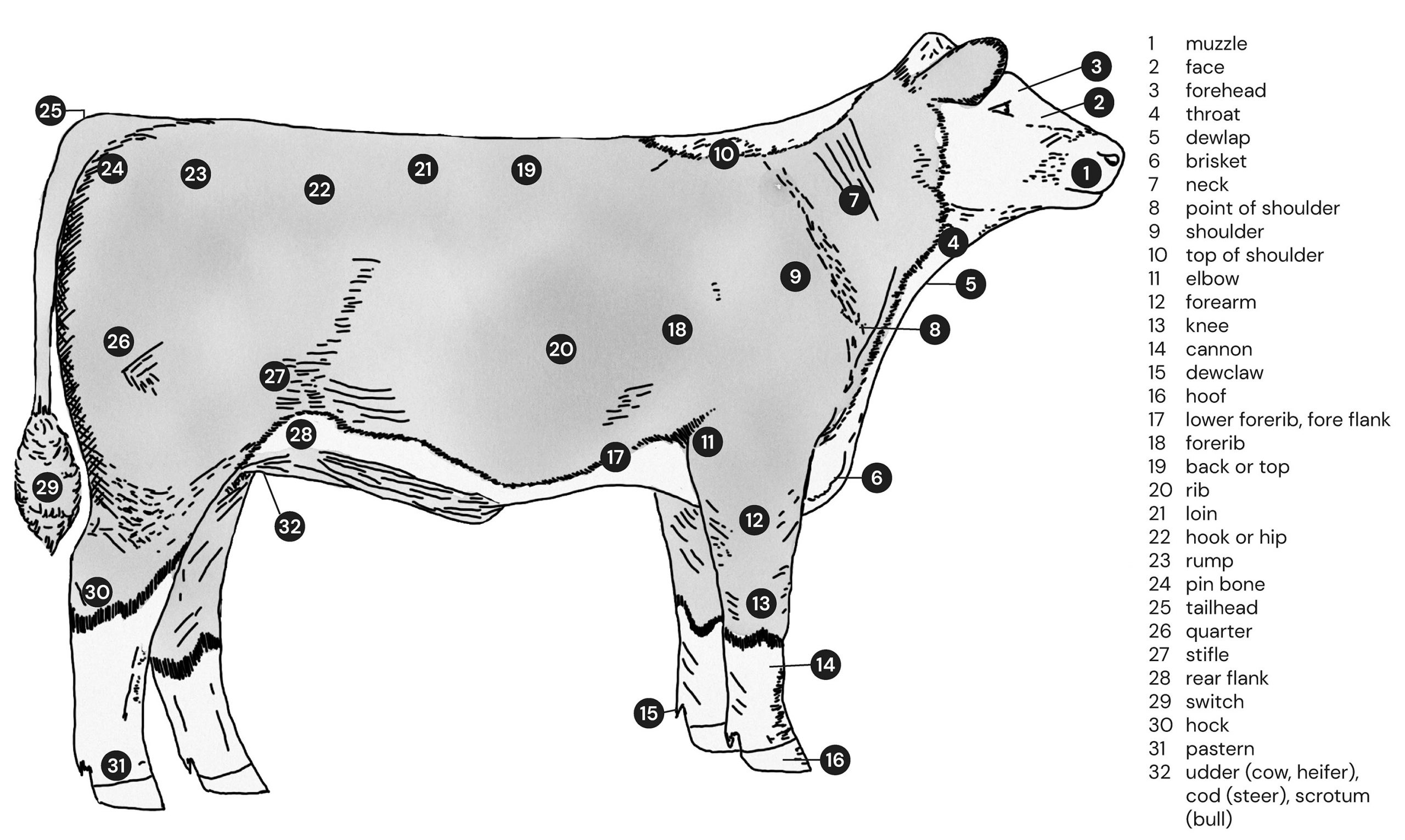
Prime cattle
When assessing fatness of live animals, you should observe and feel several sites on the animal i.e. at the 12th/13th rib or P8 rump site.
Visually the most important sites to assess fatness are around the tailhead and over the ribs.
Other sites are the cod, twist, brisket and flank, however these sites are fat depots and indicate when an animal is becoming overfat and so are less useful for determining fatness within the requirements of most markets.
The areas to feel manually are the short ribs of the loin (A), over the long ribs (B and D) and around the tail head (C) (see overleaf).
For cattle up to about 15mm the rib sites A and B and the tailhead C are the most useful, with particular emphasis on C.
Pinch out a fold of skin next to the tail (anal fold) to feel how much fat there is. As the skin is about 6mm thick, deduct 12mm from the total thickness to estimate the fat thickness under the skin.
Use the rib sites (A and B) as a cross check. It may also help to feel the hip bone.
For older fatter cattle, the ribs and tail may be quite buried in fat. In this case, site D behind the shoulders is quite useful. Place a hand flat on the hide to estimate the thicknesss of fat between the hide and the ribs.
Research shows that fat depth at the 12th/13th rib site is more highly correlated to yield than measurements at the P8 site.
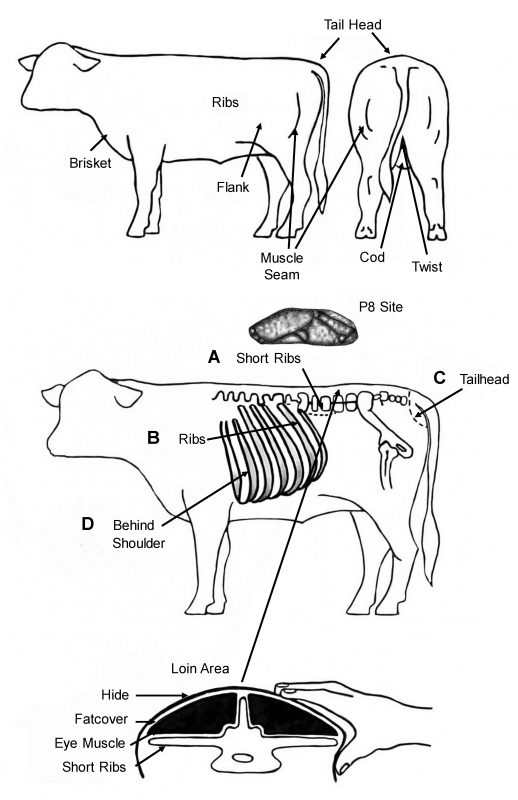
As cattle finish:
• Ribs become less visible.
• Tailhead softens with rounds of fat developing around the tail.
• Muscle seams of the hindquarter become covered with fat and are less evident when the beast walks.
• Brisket, flank, cod and twist all fill out giving the animal a rectangular appearance compared to the roundness of leaner, heavily muscled cattle.
Muscle assessment
While there may be some debate as to the importance of carcase conformation or muscle shape, research has shown that there is a correlation between the increase of yield and the increase of the live muscle score (not carcase muscle score) with the same liveweight and fatness.
Muscle assessment does not infer a quality standard but rather describes the thickness and shape of the muscle in relation to frame size and should always be compared within animals of similar age and frame (maturity) type.
Always assess fatness first – it is easy to be too generous in muscle scoring very fat cattle.
Observe cattle from behind to assess the thickness through the lower hindquarters (stifle).
Heavily muscled cattle are thicker through the stifle than light muscled. They also stand with their hind legs further apart than lighter muscled animals.
From the side, observe curvature of the muscles of the thigh. Muscle seams are clearly evident in heavily muscled leaner cattle.
Also observe the thickness of the fore-leg. Heavily muscled cattle have a more expressive fore-leg than more lightly muscled cattle.
The basics of structural soundness
The basic structure of a bull is all about angles and symmetry: angles between joints, angles of the foot to the ground, and symmetry between the hooves, muscularity of the hind quarters and balance between the front and rear end.
Any departure from normal angularity alters weight distribution and point of balance across the joints leading to inflammation, impaired serving ability, and increased wear and tear of the joint.
In the fore-end, the angle between the shoulder blade/shoulder/elbow should be 90- 95º. An angle greater than this means that the bull is straight-shouldered, often with high and open shoulder blades which if inherited by his progeny contributes to birth difficulty.
Similarly, the angle between the hip/stifle/hock should also be 90-95º. An angle greater than this means that the bull will be straight-legged, short step, and be more susceptible to service injury. The basic angularity of the joints is shown in the following illustration.
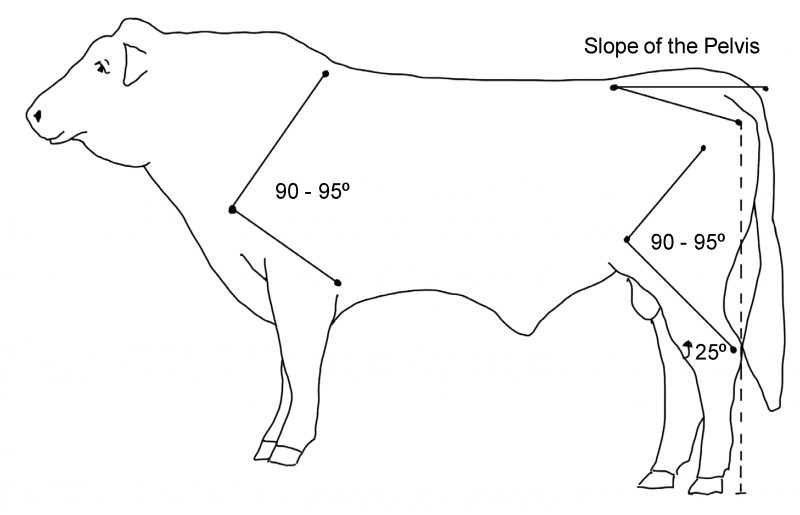
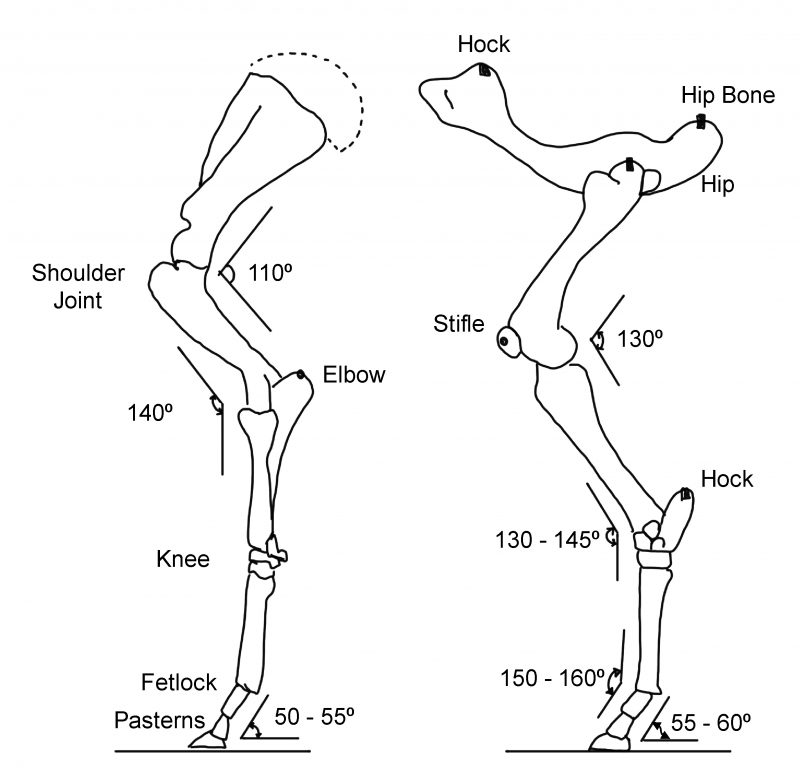
Locomotion
While it is difficult to measure the above angles at a bull sale, a structurally correct bull will have a free moving gait, with the hind feet stepping into the footprints of the front feet. Over or under-stepping of the hind feet are indications of angulation problems and are reflected in long/sloping feet or short/blocky feet respectively.
Likewise if the bull is suffering arthritis in one leg, it may tend to short-step or drag a leg on that side. An arthritic bull will also show muscle wasting over the rump and leg muscles of the affected side.
The front end
Shoulders
The shoulders are naturally sloping and shoulder blades should slope 45-50° from vertical. A bull with shoulder blades tipped forward (straight shouldered) has less angle at the shoulder/elbow joint which reduces the shock absorbing ability of the front legs. Straight shouldered bulls tend to walk with a short, choppy gait and will carry the head low, with the tip of the shoulder blade prominent above the backline.
The shoulders should be smooth against the rib-cage. Bulls which are wide between the shoulder blades may sire heavy shouldered calves with increased risk of calving difficulty.
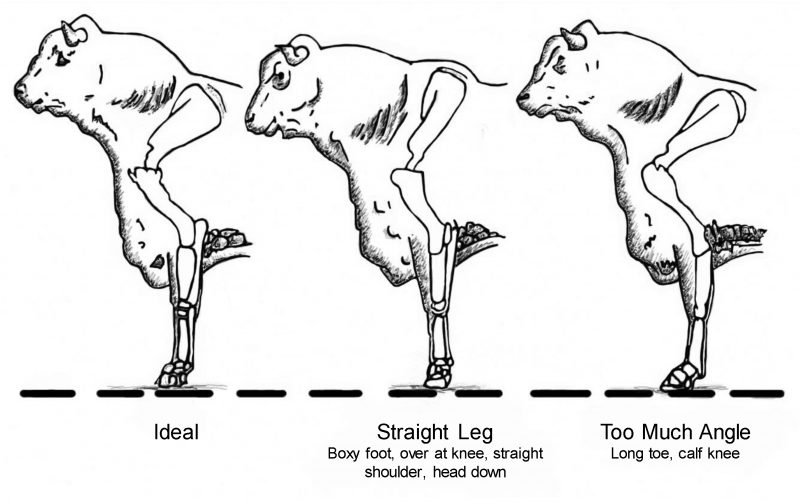
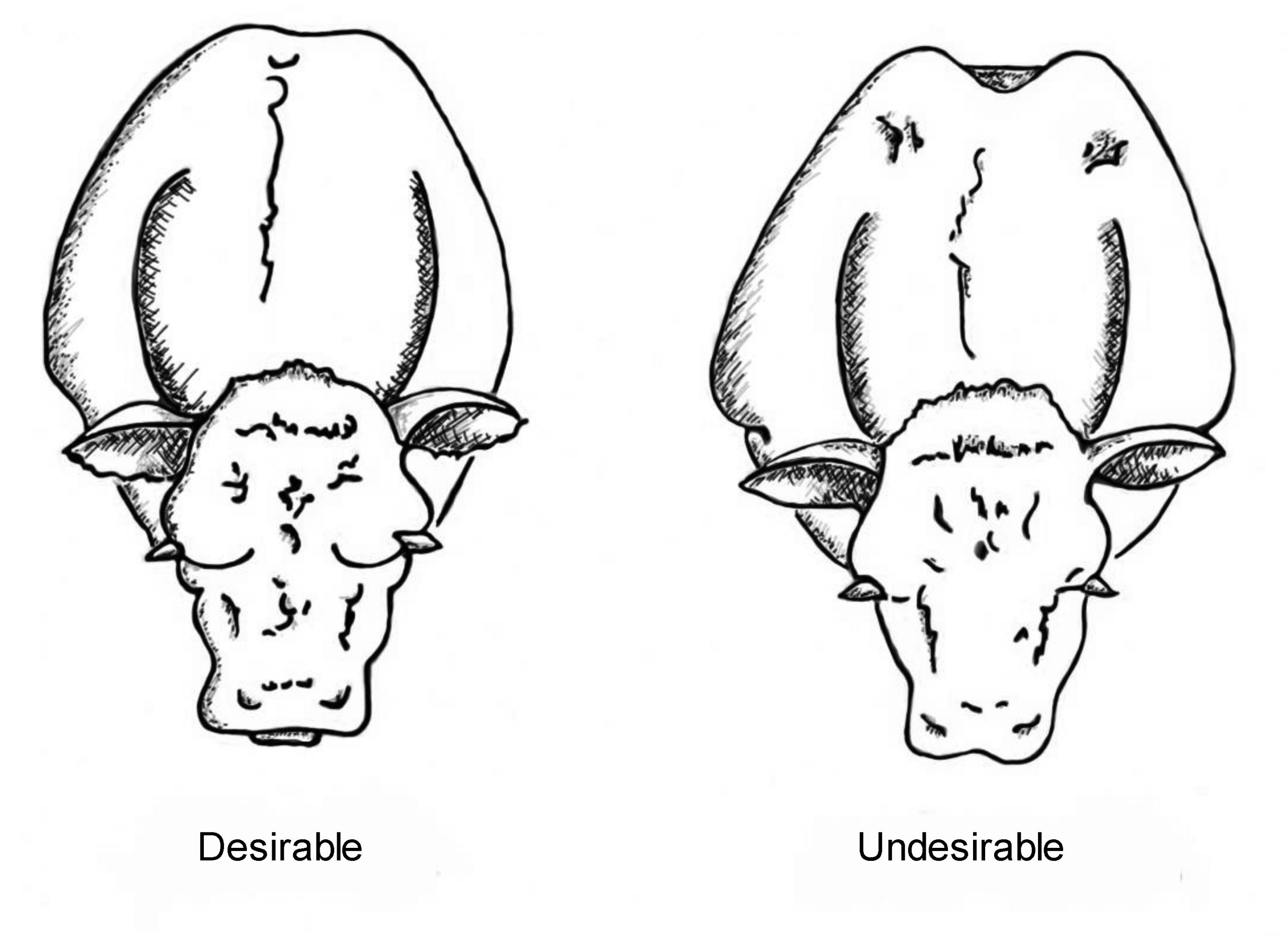
Front legs
The front legs of the bull should be straight when viewed from in front although a slight turn out is normal in undomesticated animals.
A ‘knock-kneed’ bull will have turned out front feet (up to 10° is considered normal). Knock-kneed bulls may show overgrown outside claws which will contribute to lameness.
A bull that is wide at the knees (bow-legged) presents a more serious problem. These animals are often narrow in their stance and may roll their feet as they walk. They tend to be more prone to arthritis.
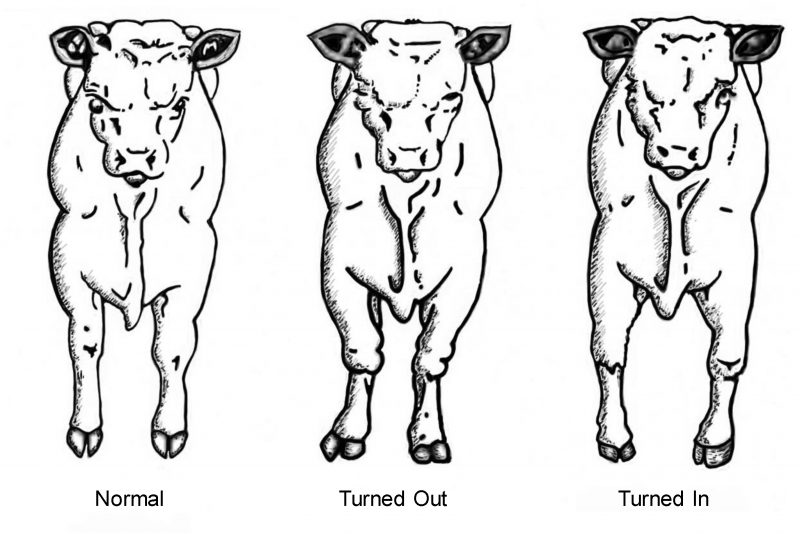
The rear end
Hind legs
More bulls break down from problems associated with the hind leg than from any other reason.
Correct structure of the hind leg is all about angles at the joints of the hip, stifle, hock and pastern joints. The angles, which are apparent in the stance of the bull when viewed side-on are critical, particularly during serving when large amounts of stress are placed on these joints.
Deviations from the correct angles will cause excessive wear and tear on the joints, leading to early breakdown.
When a bull mounts a cow, the joints in the hind legs are straightened. When thrusting, the legs are further straightened, placing enormous stress on all joints, but particularly the hock. If these joints don’t have enough angulation, they quickly become swollen and painful, leading eventually to breakdown. Straight legged bulls are often clumsy servers and suffer a higher incidence of broken or damaged penises during serving.
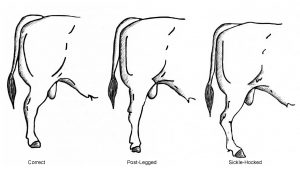
Too much angle through the hock joint (straight/post-legged) is a serious structural fault.
These cattle don’t have the flexing and shock absorbing effect of the structurally sound animal, and they are prone to severe wearing of the hip joint, leading to arthritis. Bulls showing arthritic problems are reluctant to serve cows as the condition can be quite painful. Too little angle through the hock joint (sickle hocked) is not as damaging as post-leggedness, though undesirable.
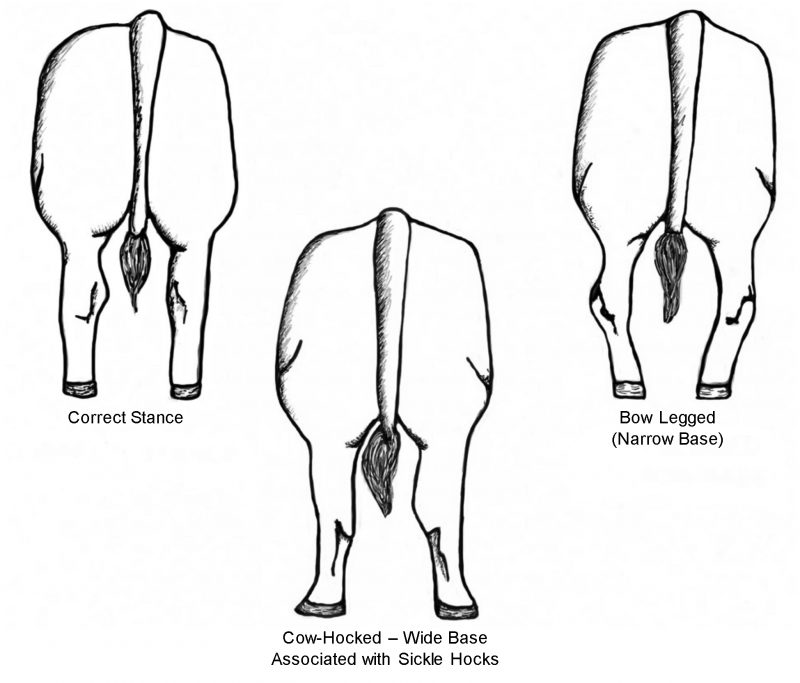
Viewed from behind, the leg through the hock joint should be close to vertical. A bull is ‘cow hocked’ when the hocks are rotated inwards and the hooves rotated outwards. This may cause problems but usually only in extreme cases where uneven pressure on the claws causes the outside claw to grow long. A more serious problem occurs where the legs are wide at the hocks (bow-legged), but the feet are turned in. Extra strain is placed on the ligaments of the hock joints causing lameness and even permanent damage.
Feet
A normal foot should have claws of equal size, at 45º slope to the ground. Deviation from this angle is usually an indication of poor leg structure/angle. Foot defects are exaggerated by heavy feeding and soft ground. Avoid overgrown, scissor or curved claws as these conditions will worsen as the bull ages, caused by overgrowth where the toe loses contact with the wearing surface of the ground.
Scissor claws and uneven claw size/shape are considered to be inherited defects.
Long sloping claws or short blocky claws indicate too much or not enough pastern angle, causing the hoof to wear abnormally and will affect the mobility and performance of the animal.
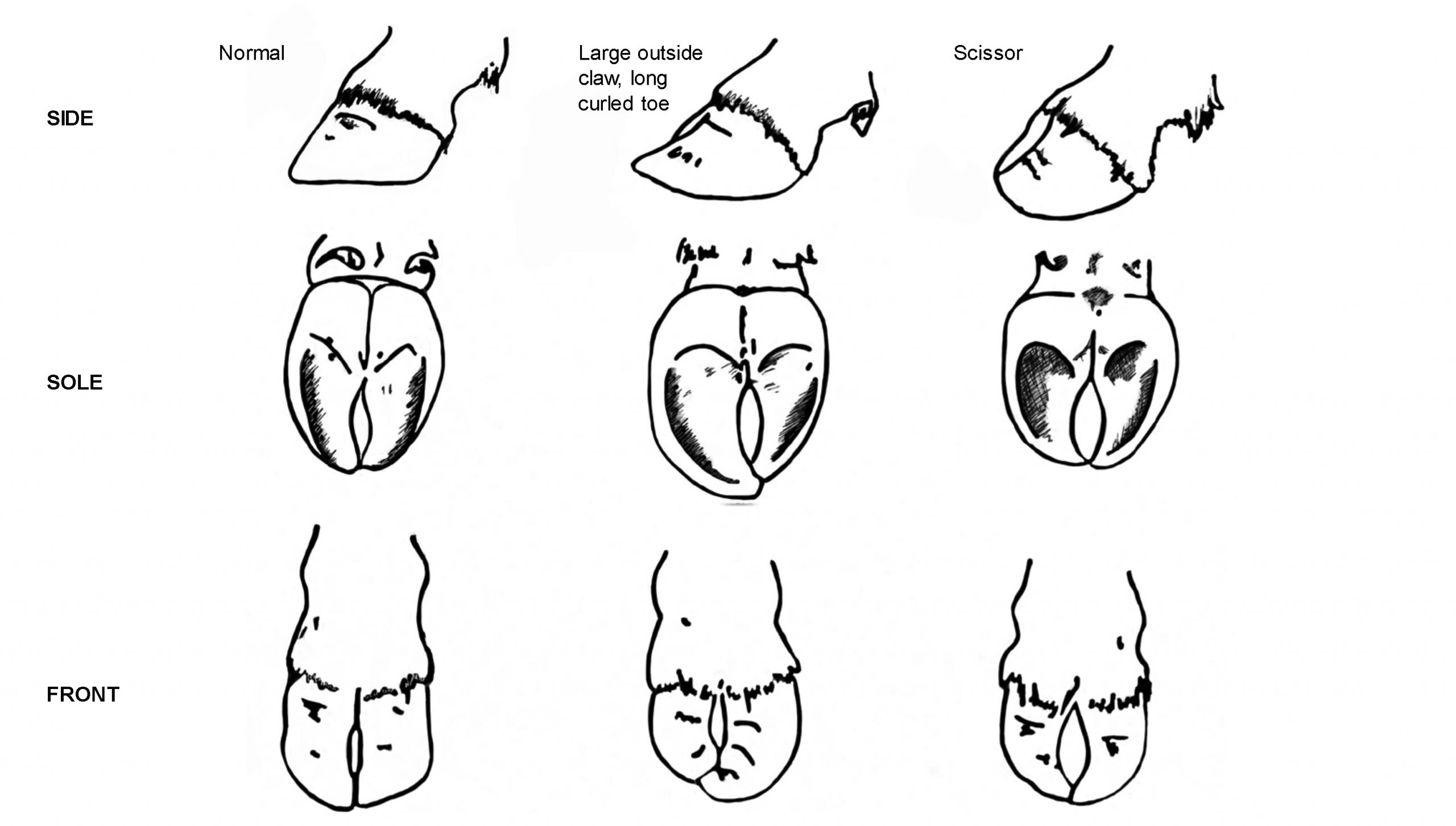

In the front feet, short blocky feet indicate a shoulder that is too straight. The figure below indicates the correct angle of the pastern joint.
Even minor feet defects in young bulls should be taken seriously as the defect will become more pronounced as the bull gets older and heavier. They will also become exaggerated when the bull is exposed to heavy/wet soil conditions, heavy grain feeding or lack of exercise.
The sheath
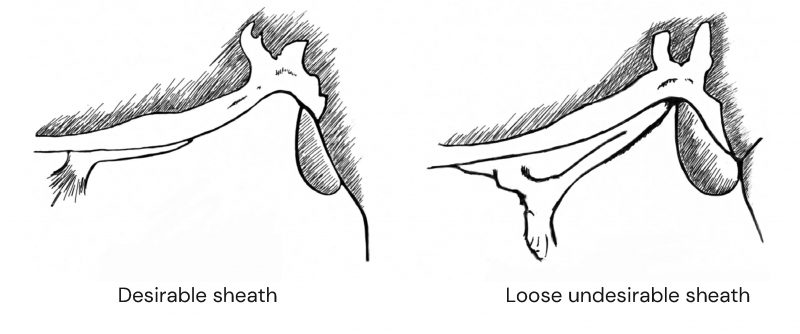
The sheath should be trim and close to the body. A loose sheath is more prone to injury or infection (from grass seeds, and other foreign objects) and should be avoided. Tropical breeds are however more susceptible to these problems.
A slack prepuce (hanging down of the pink, inner mucosal cover of the penis) should also be avoided.
While some drop of the prepuce during urination is normal, a bull whose prepuce is visible all the time should be regarded as having structural fault.
Testicles
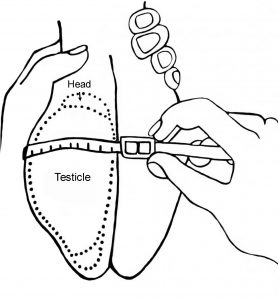
The two testicles should be of similar size and consistency, and should feel firm and springy. Soft, spongy testicles indicate a break-down of the sperm producing tissue and such testicles produce low quality semen, usually with a high percentage of abnormal sperm.
The amount of semen produced by the testicles is highly related to their size, or volume and the more sperm producing tissue there is, the more sperm that are produced.
The best method of evaluating a bull’s semen producing ability is to measure the circumference of the scrotum. Bulls 18 months and older should have a scrotal circumference of no less than 32cm, and well developed 18-24 month old bulls will have a scrotal circumference greater than 35cm.
To measure the scrotal circumference, stand behind the bull in a crush. With one hand, force the testes to the bottom of the scrotum, with the other hand loop a tape measure around the scrotum encircling both testicles and pull the tape firmly around the position of greatest circumference (see illustration).
